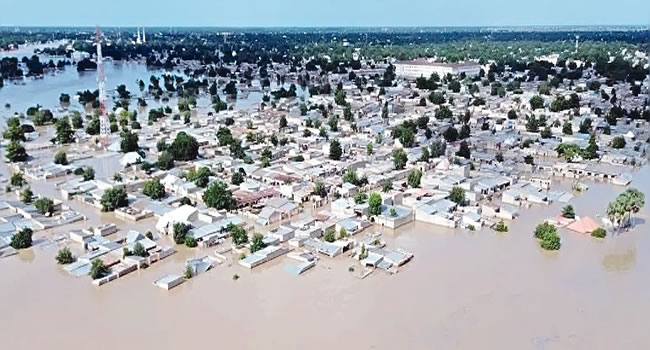
It’s the worst such flooding in the northeastern city of Maiduguri in 30 years, authorities say.
Devastating floods in northeastern Nigeria have submerged entire residential areas, displaced tens of thousands of people, and forced zoo animals to escape into the streets.

At least 30 people have died in the floods, officials said. However, the death toll is likely to rise as authorities are still scrambling to rescue thousands of others feared trapped in their homes.
The floods hit Borno State early this week after a dam impounding a regional river burst its banks. The heavy surge of water buried half the state capital, Maiduguri, damaging buildings and infrastructure.
Authorities say some one million people are affected, of which about 200,000 are displaced.
Floods are not uncommon in northern Nigeria. However, experts say Maiduguri is seeing its worst flood in 30 years.
The affected region is the heart of a 15-year armed rebellion led by Boko Haram that has already seen millions of displaced people living in camps, making them particularly vulnerable. Maiduguri also serves as a hub for humanitarian operations.
Here’s what to know about what caused the floods and how officials are responding:
What caused the floods?
Authorities say the floods were caused by the flow of excessive rainwater amid the rainy season, which lasts from June to September in the West African country.
The Alau Dam, located in the Konduga community just a few kilometres outside Maiduguri, burst its banks on Monday after being overwhelmed by the heavy rainfall, officials say.
The dam was built in 1986 to help farmers in Maiduguri with irrigation. In many instances, it also helps control flooding from the Ngadda River, which on occasion gets higher-than-normal inflows from water sources that trace back to the massive Lake Chad.
In 1994, heavy rains caused Alau to break, inundating Maiduguri and its surrounding areas. In 2012, the dam broke and flooded communities nearby. The number of those affected in 1994 remains unclear, while a government report said multiple flood events across several states in 2012 killed 363 people and displaced 3.8 million.
What’s happening to people in flood-affected areas?
Thousands of people are still trapped in buildings and on trees in flood-affected areas, Al Jazeera’s Ahmed Idris said, reporting from Maiduguri. To exit their homes, people must use canoes, which are not readily available in most places.
In many places, water levels have not receded. Although authorities are now helping with search and rescue, initially survivors were forced to wait for hours and were mostly helped by volunteers with minimal resources.
“People were going into the water with bare hands, very little equipment, to help try and save people from drowning,” Idris said on Thursday. “In one location we went to, the head of the rescue operation – a local volunteer group – told us they were able as of yesterday to save 200 people who were stranded in their own homes. Some were on treetops, some were on rooftops, some were clinging virtually to anything they could lay their hands on.”
Authorities are using boats for rescue operations. Crowds of people also packed onto huge military trucks that were deployed for a rescue operation on Wednesday.
Officials have recovered “many” bodies, Idris said, without giving any number. One of them was baby Humayrah, who waited with her family to be rescued for 36 hours, after seeking shelter on a boat. The boat capsized, causing the baby to drown.
Damaged septic tanks and flooded graveyards are also spurring fears of a rapid spread of infectious diseases, even as officials scramble to find shelter for those affected.
Leading hospitals in the state, including the 1,305-bed University of Maiduguri Teaching Hospital – the largest in northeast Nigeria, are also flooded.
“I have been in this hospital for the last 37 years and I have never seen something like this,” Ahmed Ahidjo, the chief medical director of the hospital, told Al Jazeera on Thursday.
“The whole of the ground floor and the centres – we have about 14 specialised centres in the hospital – they are all flooded and some of the machines they are very, very expensive … all of these machines are submerged in water.”
The hospital can still conduct emergency operations on the upper levels, but it has no electricity and has been forced to suspend admissions, Ahidjo added, as the sewage system has burst open and could infect patients.
Why are wild animals in the streets?
Another concern is wild animals swimming in the floodwaters. Officials said the flood either killed or washed away 80 percent of the animals in the Sanda Kyarimi Park Zoo in Maiduguri.
In a statement, the zoo authorities confirmed that dangerous animals had escaped, and urged residents to be careful. “Some deadly animals have been washed away into our communities, like crocodiles and snakes,” the statement read.
It is unclear how many animals were there in the zoo. It housed a wide array of wildlife, including endangered elephants and lions, as well as, hyenas, crocodiles, and snakes.
In videos posted on social media, an ostrich that appeared to have escaped from the zoo pranced around in the streets. Officials said they had managed to rescue and return the animal.
Is a food emergency brewing?
Many in Borno State, and much of northern Nigeria, were already in the throes of a punishing food emergency, amid high inflation. Malnutrition cases have surged in the region as the lean season ends, with 4.4 million people lacking food, according to the World Food Programme.
The ongoing war waged by Boko Haram also means hundreds of thousands of people live in tents in camps meant for internally displaced people (IDPs) across Maiduguri and depend on food from aid organisations.
“Half of the city is now underwater. Now what is happening also in the camps is that people are really, really desperate,” Idris said. “Some people have been there for more than 48 hours and they haven’t seen any help.”
Al Jazeera’s Fidelis Mbah, also reporting from Maiduguri, said: “[Some] IDP camps were totally [evacuated], so authorities have moved some people to the few ones that are not flooded.
“Some have been moved to schools, churches, mosques because there really is nowhere else to go.”
Adding to their woes, farmers in the food-producing country have been targeted by armed groups and killed on their farms in recent years. Experts have attributed the food crisis in the region partly to reduced local cultivation.
While the Borno government has distributed money to those affected by the flood to buy food this week, there is hardly anything to buy as markets have flooded, Idris said.
“Most of the food stored in the market has been flooded, some of it totally destroyed, and the little that is in Borno State will not be enough to feed the huge numbers of people displaced by this disaster,” he said.
Warnings about the floods appear to have been sounded months ago, although it is unclear why the country’s national disaster agencies, and the state government, were not more prepared for the flood.
“About two weeks ago we issued a national red alert … and every year we issue a national flood outlook showing this is how the flooding will be,” Femi Babajide, a director of the National Hydrological Services Agency, told local Arise News station.
Courtesy: www.aljazeera.com
READ ALSO: NERC: Abuja Disco to pay N1.69bn fines for overbilling customers








